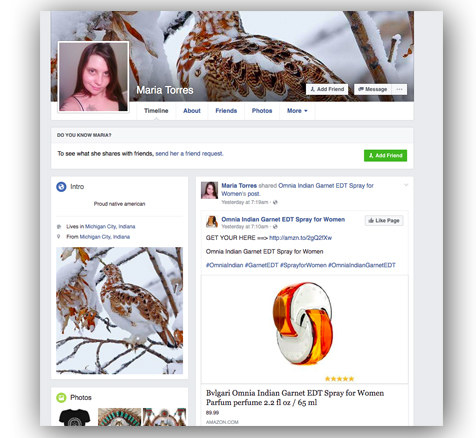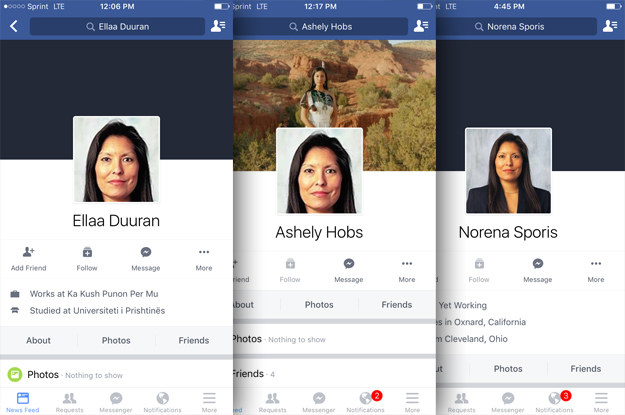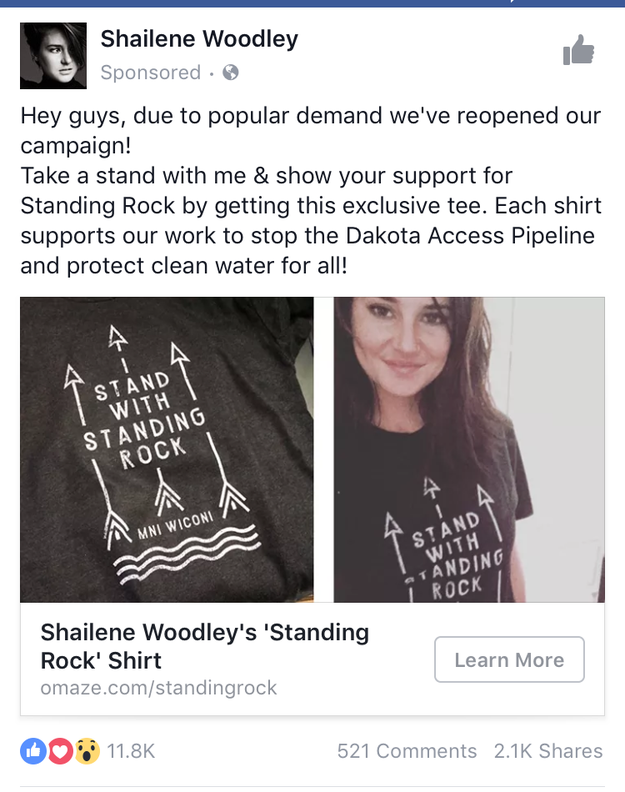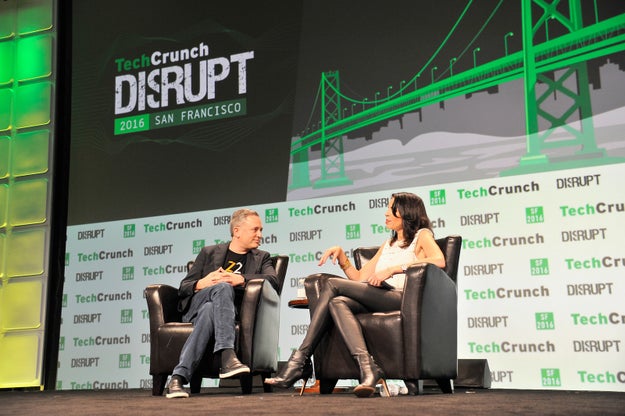
Getty Images / SunFrog
As pipeline protesters at Standing Rock prepare to dig in for the winter, a growing network of dubious Native American Facebook pages is cashing in on the movement by selling stolen No DAPL T-shirt designs and by driving traffic to dubious clickbait websites, a BuzzFeed News investigation has found.
The owners of these pages and websites reside in faraway countries such as Vietnam and Kosovo, and they are capitalizing on online interest in Standing Rock, and Native American culture in general, to make money. BuzzFeed News identified more than 60 Facebook pages with more than 6 million fans that are generating money either by selling counterfeit Native American merchandise, or by driving traffic to ad-filled websites that in some cases have little or nothing to do with Native American issues.
Native designers say their work is being stolen and resold, and that some pages falsely claim to donate proceeds to the protesters at Standing Rock.
“They’re just capitalizing on struggle — it’s really crazy,” said Jared Yazzie, a Navajo who runs Oxdx, Native American clothing company in Arizona. He said some Facebook pages have even taken photos of his models and photoshopped different clothing on them.
“When they use my models I think that makes me the most angry,” he said.

Erica Moore with two people wearing one of her Standing Rock T-shirt designs.
Erica Moore / Via instagram.com
Erica Moore is a 23-year-old Native American who designed a series of T-shirts to help raise funds for the pipeline protesters. She said copies of her designs soon began showing up on Facebook and elsewhere.
“It's a different story if they would ask our permission to use the design, but I&039;ve seen my designs being sold without my consent, and I&039;ve seen people trying to re-design my design in some way to make it their own,” she said. “It just isn&039;t right.”
BuzzFeed News tracked some of the worst offending Facebook pages to owners in Vietnam. Like If You Love Native Americans has almost 190,000 fans and is connected to a website registered to “Hoai Thu Ngo Thi” in Vietnam. It promotes its T-shirts by photoshopping them on celebrities such as The Rock, Johnny Depp, Mark Wahlberg, and others. Many of its recent posts about clothing comment on the Standing Rock protest, though there is no evidence that the people running the page donate any proceeds to the protesters.
BuzzFeed News messaged the page on Facebook and the person who replied introduced themselves as a woman in Michigan named Maria Torres who claims to be Native American on her Facebook profile. The profile appears to only have been created in March of this year and primarily shares merchandise being promoted by the Like If You Love Native Americans page. The account also reposts content and merchandise from a page called Wolves In Native American Culture which points to a domain name registered to the same person in Vietnam.
Asked how the page gets its designs, the person running the page responded, “The clothing and fashion design industry is highly competitive; it is full of individuals.”

The fake Maria Torres profile on Facebook.
Facebook
After being told records show they are in fact located in Vietnam, the person admitted that’s where they are based, meaning the Maria Torres account is a fake created to promote its content and products. The person then denied stealing designs from Native artists.
“No steal their work,” they wrote in all caps. “I am an affiliate marketer search designs on that site an [sic] sell.”
The person said they simply find Native American T-shirts that have already been uploaded to SunFrog and collect them on one page, earning a commission each time they sell. SunFrog is one of several websites that enable anyone to to upload a design and then offer print-on-demand ordering for a range of clothing.
Kirk Yodzevicis, SunFrog’s general counsel, confirmed that people can create collections of existing designs uploaded to SunFrog, and said the company takes down any infringing designs and closes the related account. He pointed to a form on its website that anyone can use to make a claim.
“When we find out somebody stole a design they get their account shut down,” he said. He also said anyone who falsely claims to sell clothing in support of a cause will have their account closed and SunFrog will donate their earnings to charity.
Yodzevicis said SunFrog has seen an increase in infringing designs and false charity claims related to Standing Rock.
“Absolutely, no question about that,” he said. “Anytime there is any kind of an issue in the news that has some kind of passion about it you are gonna see people that are going to try and game the system.”
One of the bigger pages identified by BuzzFeed News is called Indigenous People of America and has over 750,000 fans. It shares a steady stream of news related to events in Standing Rock, but under many of its posts it also promotes the sale of a knockoff of a shirt created by actor Shailene Woodley to raise funds for Standing Rock. The page also regularly posts content from a website called TheIndigenousPeoples.com, which was only registered in early November and has its owner’s name hidden.
The only official seller of the Woodley shirt is Omaze, yet the design can be found for sale on many other online clothing sites as well as on Amazon. SunFrog removed a version of the shirt for sale on its site after being alerted to it by BuzzFeed News, though other copies of the design remain for sale on the site.
There is no evidence that any of these sellers donate money to Standing Rock, or that they had permission to sell Woodley’s shirt. (A rep for Woodley did not respond to a request for comment.)
Another big Facebook page hawking inauthentic Native American goods is Native American Indians, which has over 360,000 fans and promotes merchandise from a store called NativeThing.com. That website is registered to “Hoang Trung Hieu” of Vietnam. It’s the subject of a litany of online complaints from people who bought boots and other items under the impression that they were authentic Native designs and craftsmanship. Once they receive their order people realize it was made in China, gives off a noxious odor, and that the company subsequently refuses to accept returns.
“You get stuck with the smelly product you can&039;t wear,” wrote one woman on Facebook. “How many ways can you spell ‘screwed.’”
Many other pages pursue a similar strategy of building up an audience with Native content and then trying to sell them shirts and other items that are often rip-offs of Native designs. One newer page is called I Stand with Standing Rock Sioux Tribe and shares a steady diet of news about the protest mixed with constant pleas for people to show their support by buying shirts for the cause. The page did not respond to a question about whether it donates any money to the tribe.
Along with stealing the work of Native artists, and the likenesses of models and celebrities, some scammers even used a photo of the first Native American federal judge to create fake profiles to help spread their content.

Fake profiles featuring the photo of Judge Diane Humetewa.
Facebook
Judge Diane Humetewa serves as a United States District judge of the United States District Court for the District of Arizona. Her photo has been used on at least three fake Facebook profiles, one of which lists its two only friends as two young men in Kosovo. One of the men did not reply to an interview request from BuzzFeed News, and the judge’s chambers declined to comment, citing the Code of Conduct for US Judges.
One of the largest networks of Native American Facebook pages initially identified by BuzzFeed News belonged to two young men in Kosovo. One of the men, a 25-year-old named Dardan, said in a Skype interview that he only owns “two or three” Native American Facebook pages. But when asked if it’s possible that he in fact owns 13 pages as well as a Native American group with more than 15,000 members, he smiled and said, “Maybe. It could be.”
At the time of the interview, their pages had close to 2 million fans. However, after speaking to BuzzFeed News all of their pages were taken offline.
Rather than selling Native American designs, the pages has been used to promote links to a single website, BuzzDuzz.net, where Dardan and a partner publish clickbait articles about a wide variety of topics, though rarely about Native Americans.
“Lately most of the content [on the Facebook pages] is not about Native Americans,” he said. “It’s hard to get content just about Native Americans and I don’t have time for that.”
Dardan did not respond to a subsequent Facebook message from BuzzFeed News asking why they had removed their Native American Facebook pages. BuzzDuzz is still publishing as of this writing.
Some of the Native American designers who spoke to BuzzFeed News said the non-Natives running the pages and selling stolen designs are making more money than they are.
Aaron Silva, a Native American and the co-founder of The NTVS clothing brand in Minnesota, said the dubious Native American sellers often have one or several large Facebook pages to use to promote the merchandise. Silva also said these pages spend money to create sponsored Facebook posts that promote the item for sale to large numbers of people.
“These pages are taking our work and paying for the sponsored posts on Facebook and making tons of money off of us,” Silva said. “Just from the sponsored posts we do we’ll get maybe 1,000 to 2,000 likes and maybe generate 1,000 in sales off of like a $200 ad.”
He said he’s seen sponsored posts from dubious Native American pages that receive tens of thousands, or even hundreds of thousands, of likes and a large number of shares as well. “It tells me tons of people are seeing [the ad], and you can see in the comments that many people are buying,” he said.
BuzzFeed News found sponsored Facebook posts from the Native American Cultures page, which appears to only have been created in September, that fit Silva’s description. One of its current sponsored posts shows photos of Bernie Sanders and celebrities with the Shailene Woodley shirt. It asks people to “Support The Standing Rock Sioux Tribe” and to buy the shirt, but the link does not send people to her official sales page. This sponsored post for a stolen design has received over 125,000 reactions, 15,000 comments, and close to 18,000 shares as of this writing.

Facebook
Another sponsored post from the page shows Johnny Depp with a Native shirt design photoshopped onto him. It had over 33,000 reactions, nearly 4,000 comments, and over 8,000 shares. These sponsored posts also help grow the number of fans for that page: When BuzzFeed News first found the Native American Cultures page roughly two weeks ago, it had just over 57,000 fans. It now has over 72,000.
To put this into perspective, the engagement for that page’s sponsored posts is significantly better than a legitimate sponsored Facebook post currently running from Woodley herself. It has close to 12,000 reactions, just over 500 comments, and 2,100 shares as of this writing. (It’s possible the other sponsored posts have been running longer, or have been backed with more money, in order to accrue more engagement.)
“Facebook prohibits advertisements, which includes boosted posts, that are deceptive, false, or misleading, including deceptive claims, offers, or business practices,” a Facebook spokesperson told BuzzFeed News. “We are looking into these claims and will take appropriate action.”

Facebook
Silva tried to raise awareness about the fake Native pages by listing some of the worst offenders in a post on his company’s Facebook page. The comment thread was soon filled with people sharing other examples of suspect pages, and of designers talking about how they too had their work stolen.
Silva and others have also tried to contact T-shirt sites such as SunFrog and TeeChip to get their designs removed. They said the takedown forms and procedures take up a lot of their time.
“I’ve gotten a few of them removed that way but it’s so tedious,” he said.
Yodzevicis from SunFrog said their reporting form has only a few fields to complete and submissions are checked roughly every hour. He said anyone whose work has been stolen could simply email legal@sunfrog.com if they find the form too time consuming. He also said the company is working to implement a procedure whereby any money earned from a stolen design will be sent to the original artist.
“We are currently in the process of implementing a system wherein such funds, rather than being redirected to charity, can be claimed by an actual rights holder so they are actually compensated for their work and the use of their property,” he said.
Silva said Facebook is easier to deal with, but that it only removes the offending post rather than an entire page. (The company told BuzzFeed News it will remove an entire page in some circumstances.)
Yazzie has also tried directly contacting the Facebook pages that promote his stolen designs for sale. But at most he says they will delete the post with his design and just upload it again later.
“I’ve tried to send messages to one of the pages and at first I just got this automated message back, and then they replied with a lot of smiley face emojis back, which is kind of annoying,” he said. “They eventually blocked me from commenting on their page.”
It’s not lost on Yazzie and others that Native American culture and goods are yet again being appropriated by others for profit.
“It weighs heavy,” he said. “I hope people understand there is a livelihood behind [the designs]. The meaning that goes along culturally with the work is something we study and try to put out correctly.”
For his part, Silva is amazed at how so many people in different parts of the world have discovered that dubious Native American Facebook pages, websites, and merchandise can be a moneymaker.
“I wonder how they came across that working for them,” he said. “Did they try different ethnicities and cultures and see which one really hit?”
Quelle: <a href="Facebook Scammers Are Profiting From Standing Rock By Stealing Native Artwork“>BuzzFeed


















